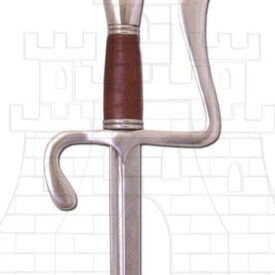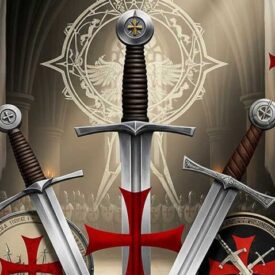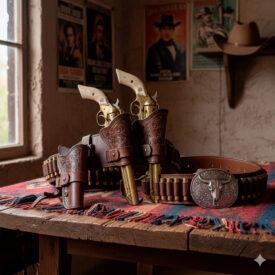The halberds are weapons that have left a significant mark on European military history. These polearms, known for their impressive appearance and versatility on the battlefield, have earned a special place in medieval history. In this article, we will thoroughly explore what a halberd is, its origin, functions, who wielded them, and their current use. Get ready for an exciting journey through time as we discover the fascinating world of halberds.
The Medieval Halberd was the hybrid weapon that dominated battlefields. Have you ever wondered how medieval armies adapted to the challenges of heavy armor and cavalry? One of the most compelling answers lies in the halberd, a polearm that became a key piece in European infantry and a symbol of status over time. This fascinating instrument of combat and ceremony has a rich history that deserves to be explored.
What Exactly is a Halberd?
Let’s start by defining exactly what a halberd is. The term “halberd” has an etymological path that leads us to the Germanic word helmbart, which means a combination of “handle” (helm) and “axe” (barte). This already gives us a clue about its nature: the halberd is a formidable weapon that combines several functions into a single tool.
Imagine a long shaft, which could measure up to two meters in length, with a multifunctional head at its end. This head typically features:
- A spear-like tip for thrusting.
- A transverse blade with a crescent or axe-like appearance on one side.
- Often, a sharp hook on the opposite side of the blade.
Basically, it could be described as a pike with side blades. This unique combination of elements makes it distinctive and powerful on the battlefield. This versatility allowed the warrior to stab like with a spear, cut with the axe blade, and even unseat riders from their horses or bring them down with the hook. It was truly a versatile weapon!
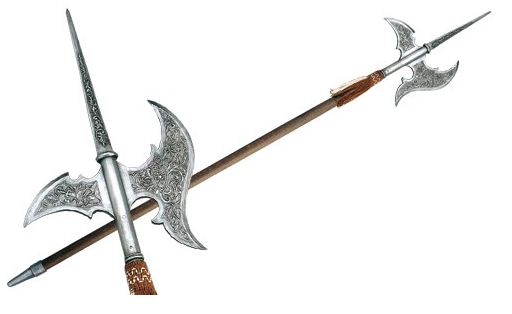
A Journey to Its Origins and Evolution: From Stone to Steel
The history of the halberd dates back to the 14th century, when this weapon was introduced to Europe from China, where polearms with similar functions already existed in antiquity. It is believed that it was the Scandinavians and Germans who brought the halberd to Europe, quickly spreading from these regions.
Although there are disputes about the exact origin of the halberd in Europe, some historians point out that this weapon has its roots in Denmark and was introduced to the Iberian Peninsula by Swiss infantry in the service of the Catholic Monarchs during the capture of Granada. The use of the halberd quickly spread throughout Europe and became an iconic weapon of the Middle Ages, used until the 17th century. Its versatility and ability to adapt to different combat styles made it invaluable in various war situations.
The halberd did not appear out of nowhere; it logically evolved from the axe. Initially, a primitive axe consisted of a stone head attached to a pole. With advances in metallurgy, the stone head was replaced by metal. The crucial change that gave rise to the halberd was the creation of two holes in the head to secure it more firmly and the elongation of the upper end of the axe to form a rudimentary spear point. Over time, a “pick” or hook was added, and all parts were merged into a single forged head. Halberds from the 14th to 15th centuries were the most common weapon in infantry in all European armies, marking a milestone in the evolution of weaponry.
Functions of the Halberd: Versatility on the Battlefield
One of the most notable features of the halberd is its versatility on the battlefield. This weapon was capable of performing multiple functions, making it a valuable resource for medieval soldiers, allowing them to adapt to various combat situations, from clashes with cavalry to duels with heavily armored infantry.
1. Thrusting and Stabbing: The Spear Tip
The sharp spear tip at the end of the halberd allowed it to be used as a traditional spear. This made it an effective weapon for stabbing and attacking from a distance, keeping enemies at bay and penetrating lighter armor or the gaps between plates. The ability to thrust was crucial for maintaining formation and repelling cavalry charges or infantry advances.
2. Devastating Cuts: The Axe Blade
The transverse axe-shaped blade on one side of the halberd gave it the ability to deliver effective cuts to the armor and shields of enemies. This function made it especially effective in close combat, where a well-placed blow could disable an opponent or even cut through chainmail and thinner plate armor. The force of an axe blow, combined with the reach of the shaft, made it formidable.
3. Unseating and Disarming: The Strategic Hook
The hook on the back of the halberd had several strategic functions. It could be used to unseat riders from their horses by hooking their saddles or armor, unbalancing them and bringing them to the ground, where they were vulnerable. It was also useful for catching and disarming opponents in close combat, hooking their weapons or limbs to immobilize or knock them down. This feature added a unique tactical dimension to the halberd.
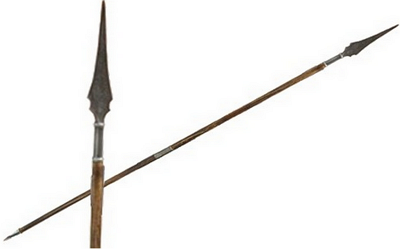
In summary, the halberd was a true all-rounder on the battlefield, able to adapt to a variety of situations and military strategies, making it a pillar of medieval infantry and a weapon feared by its adversaries.
The Halberd at Its Peak: Epic Battles and the Rise of Infantry
The halberd gained immense popularity thanks to its use by Swiss mercenaries. These soldiers, famous for their service in foreign armies, demonstrated the weapon’s effectiveness in historic battles such as Morgarten (1315) and Sempach (1386), where the halberd decisively contributed to their victories. It was especially effective against metal plate armor over chainmail that began to be used at that time, allowing infantrymen to “cut their heavily armored opponents as with a razor.” The discipline and formation of the Swiss pikemen, combined with the lethality of the halberd, made them unstoppable for a time.
By the end of the 15th century, the appearance of long spears among German Landsknechts caused the halberd to lose some ground in front-line formations. At that time, its use was restricted to the most experienced warriors and it became a distinctive weapon for junior officers, who used it to lead their troops and as a symbol of their rank. This transition marked the beginning of its evolution from a mass combat weapon to a more specialized and status instrument.
Throughout the 16th century, the halberd maintained its relevance, although its role on the battlefield continued to evolve. However, in the 17th century, it began to disappear as a main combat weapon due to the advancement of firearms and the bayonet, which offered greater tactical flexibility and superior firepower. Despite this, its legacy and impact on military history were already firmly established.
Diversity and Ornamentation: From War Tool to Symbol of Prestige
The halberd was not a static weapon; it constantly changed in shape, size, and weight, adapting to different countries and eras. German and Italian halberds, for example, showed notable differences in the design of their heads, reflecting the tactical and aesthetic preferences of each region. This diversity is a testament to the weapon’s adaptability and the creativity of armorers.
During the Renaissance, the design of the halberd was influenced to acquire very elaborate forms, making some of them less practical for combat and more oriented towards ostentation. For example:
- Early 16th-century Italian halberds sometimes had a very long tip and a smaller axe with an “inverted full moon” shape, making them more suitable for stabbing than cutting, and their weight decreased. These pieces were often more elegant and less robust than their combat predecessors.
- German and other halberds became true works of art, decorated with engravings, niello, gilding, intricate patterns, and coats of arms. This increased their price and transformed them from a weapon of the masses to a weapon of prestige, commissioned by monarchs and archdukes, such as the halberd of Archduke Ferdinand II of Austria or that of Prince Charles Eusebius of Liechtenstein. These ceremonial halberds were symbols of power and authority, displayed in parades and court events.
In Spain, at the beginning of the 18th century, the musket with bayonet began to replace the pike and polearms in the infantry, marking the end of an era for polearms on the battlefield. However, the halberd and other similar weapons continued to be used to distinguish ranks and elite units:
- Officers used the spontoon between 1704 and 1768, before it was replaced by the musket with bayonet in 1768. The spontoon, a lighter and more ornamental version of the halberd, served as a command insignia.
- Sergeants were distinguished by the halberd until 1787, when it was also replaced by the musket with bayonet. This highlights how the halberd went from being a combat weapon to a rank insignia.
The halberd then became the exclusive equipment of the Royal Corps of Halberdier Guards, a unit that has maintained this weapon throughout its history for its service as the Palace Interior Guard. This unit is a living example of the endurance of tradition.
In 1816, the corporals of this Corps used partisans, another type of ceremonial polearm. Interestingly, the palace guard of Joseph Napoleon had also used partisans, showing a continuity in the use of ceremonial weapons by elite guards. The halberds of the Royal Corps of Halberdiers were produced at the Toledo Factory, often with the monarch’s cipher, the royal coat of arms, and the date of manufacture engraved, making them unique pieces of great historical value.
Who Wielded Them: From Infantry Warrior to Palace Guard
The soldiers who wielded halberds were known as halberdiers. Initially, these warriors were part of the army corps and played a fundamental role on the front line. Their training and skill in handling the halberd made them a formidable force in battle, especially against cavalry and heavy infantry. They were the backbone of many infantry formations, able to break enemy lines and withstand charges.
Over time, and as military tactics evolved, halberdiers also took on other responsibilities outside the battlefield. They were assigned to guard and honor kings, princes, or nobles. Their imposing presence and skills with the halberd made them a logical choice for these prestigious tasks, where appearance and symbolism were as important as combat ability. This change of role highlights the transition of the halberd from a purely military tool to a symbol of authority and tradition.
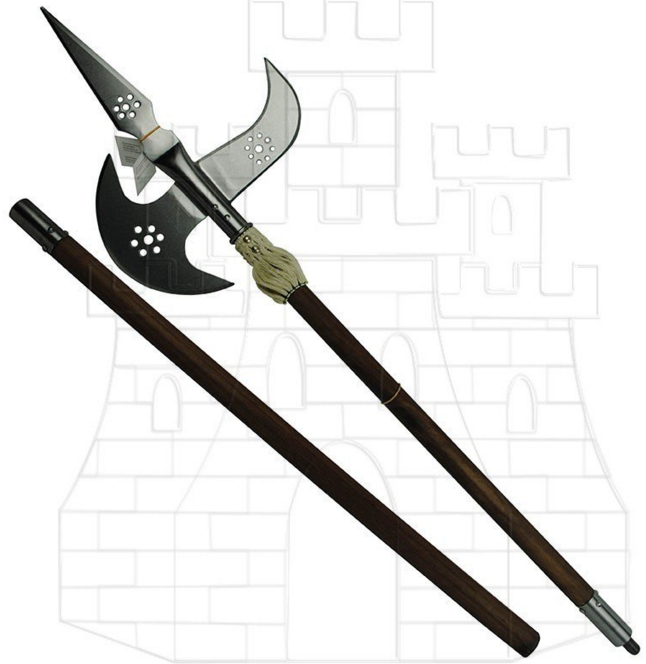
Current Use of Halberds: Living Tradition and Symbol
Although its era as a main combat weapon ended in the 17th century, the halberd has not disappeared. Today, it is a symbol of protection, tradition, and status, keeping its rich history alive through ceremonial and decorative use. Its impressive appearance and rich history make them objects of interest at various occasions and events.
Parades and Historical Reenactments: Reliving History
Halberds are often featured in parades and historical reenactments. Groups and associations dedicated to reviving moments of medieval history use these weapons to bring past eras to life. The presence of halberdiers in period costumes, armed with their halberds, creates a unique visual experience for the public and transports everyone to times of knights and battles. It is a way to keep alive the memory of these impressive weapons and the era when they dominated the battlefields.
Two prominent examples of formations that still use them are:
- The Pontifical Swiss Guard, the military corps responsible for protecting the Pope and the Holy See. Their distinctive uniforms and halberds are recognized worldwide, symbolizing a centuries-old tradition of service and loyalty.
- The Spanish Royal Guard, specifically the Company of Royal Halberdier Guards, which protects the alcazars and accompanies the Kings at public events. This unit is a direct link to Spain’s military history and the importance of the halberd in defending the monarchy.
These guards not only display them by tradition, but in some cases even use them in their training as combat weapons, keeping alive the handling skills of these historic arms.
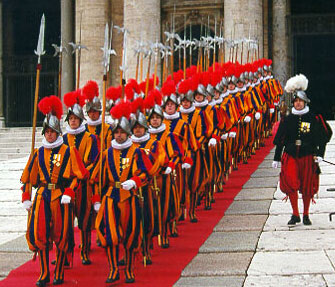
Decorative and Collectible Element: A Tangible Legacy
In addition to their use in historical events, halberds are also used as decorative elements. Their elaborate design and historical symbolism make them prized collectibles for history enthusiasts and antique weapons collectors. Many people choose to display them in their homes as conversation and decorative pieces, adding a touch of history and elegance to their spaces. These pieces, often faithful replicas or even restored originals, are a tangible reminder of a fascinating past.
In summary, halberds have gone from being deadly weapons on the battlefield to objects of admiration and respect in today’s society, demonstrating the enduring nature of their cultural and historical impact.
Halberds are silent witnesses to European medieval history. From their introduction in the 14th century to their use on the battlefield and beyond, these polearms have left an indelible mark on the military and cultural history of Europe. Their versatility in combat, their role in the lives of halberdiers, and their presence in current events show that halberds are more than just weapons; they are an integral part of the rich history of humanity. Their impact on European military history, especially in the Middle Ages, was considerable, and their legacy lives on in today’s ceremonies and elite guards.
If you want to get your own medieval halberd or explore other medieval products and weapons, we invite you to visit our medieval shop. In our catalog, you will find a wide variety of halberds, spears, and other weapons that will transport you to times past and awaken your passion for history. Don’t hesitate to explore our site and immerse yourself in the fascinating world of the Middle Ages!
At Medieval Shop, we are committed to offering high-quality products that allow you to experience history authentically. Our passion for the Middle Ages is reflected in every item we offer, and we hope you find the halberd or medieval weapon you are looking for. Explore our catalog and immerse yourself in the exciting world of medieval history!












